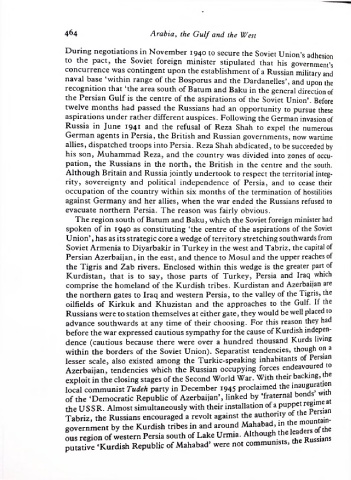Page 467 - Arabia the Gulf and the West
P. 467
464 Arabia, the Gulf and the West
During negotiations in November 1940 to secure the Soviet Union’s adhesion
to the pact, the Soviet foreign minister stipulated that his government’s
concurrence was contingent upon the establishment of a Russian military and
naval base ‘within range of the Bosporus and the Dardanelles’, and upon the
recognition that ‘the area south of Batum and Baku in the general direction of
the Persian Gulf is the centre of the aspirations of the Soviet Union’. Before
twelve months had passed the Russians had an opportunity to pursue these
aspirations under rather different auspices. Following the German invasion of
Russia in June 1941 and the refusal of Reza Shah to expel the numerous
German agents in Persia, the British and Russian governments, now wartime
allies, dispatched troops into Persia. Reza Shah abdicated, to be succeeded by
his son, Muhammad Reza, and the country was divided into zones of occu
pation, the Russians in the north, the British in the centre and the south.
Although Britain and Russia jointly undertook to respect the territorial integ
rity, sovereignty and political independence of Persia, and to cease their
occupation of the country within six months of the termination of hostilities
against Germany and her allies, when the war ended the Russians refused to
evacuate northern Persia. The reason was fairly obvious.
The region south of Batum and Baku, which the Soviet foreign minister had
spoken of in 194° as constituting ‘the centre of the aspirations of the Soviet
Union’, has as its strategic core a wedge of territory stretching southwards from
Soviet Armenia to Diyarbakir in Turkey in the west and Tabriz, the capital of
Persian Azerbaijan, in the east, and thence to Mosul and the upper reaches of
the Tigris and Zab rivers. Enclosed within this wedge is the greater part of
Kurdistan, that is to say, those parts of Turkey, Persia and Iraq which
comprise the homeland of the Kurdish tribes. Kurdistan and Azerbaijan are
the northern gates to Iraq and western Persia, to the valley of the Tigris, the
oilfields of Kirkuk and Khuzistan and the approaches to the Gulf. If the
Russians were to station themselves at either gate, they would be well placed to
advance southwards at any time of their choosing. For this reason they had
before the war expressed cautious sympathy for the cause of Kurdish indepen
dence (cautious because there were over a hundred thousand Kurds living
within the borders of the Soviet Union). Separatist tendencies, though on a
lesser scale, also existed among the Turkic-speaking inhabitants of Persian
Azerbaijan, tendencies which the Russian occupying forces endeavoured to
exploit in the closing stages of the Second World War. With their backing, t e
local communist Tudeh party in December 1945 proclaimed the inauguration
of the ‘Democratic Republic of Azerbaijan’, linked by ‘fraternal bonds wi
the USSR. Almost simultaneously with their installation of a puppet regime a
Tabriz, the Russians encouraged a revolt against the authority of the ersia
government by the Kurdish tribes in and around Mahabad, in the mountai
ous region of western Persia south of Lake Urmia. Although the leaders 0
putative ‘Kurdish Republic of Mahabad’ were not communists, t e u

